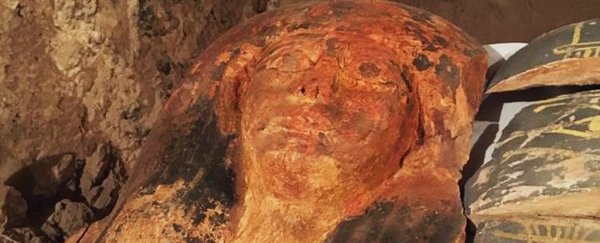An Egyptian tomb that lay unopened since it was discovered in the 1990s has now been carefully excavated, revealing a mummy which was interred with its various treasures around 3,500 years ago.
The tomb is one of two Egyptian archaeologists excavated in the necropolis of Dra' Abu el-Naga' in Luxor near the Valley of the Kings. They date back to the 18th Dynasty (1549-1292 BCE), and probably belonged to important officials, according to the Egyptian Ministry of Antiquities.
The tombs were discovered and numbered by German Egyptologist Friederike Kampp-Seyfried in the 90s. She surveyed and numbered them, but didn't actually go into the chambers.
Kampp 161 was never touched, and Kampp 150 was only excavated to its entrance. Since then, the two tombs were all but forgotten until the most recent archaeological season, when an official Ministry of Antiquities expedition finally opened the tombs.
They are not far from another resting place discovered in the same necropolis - the discovery of the tomb of Userhat, a judge who lived 3,000 years ago, was announced in April of this year.
The owners of the two newly excavated tombs have not been identified, but they were probably important (or they wouldn't have had tombs), and the grave goods and decorations offer clues as to when the bodies were interred.
Kampp 161, based on the wall paintings, engravings and inscriptions found inside, dates back to around the end of the reign of pharaohs Amenhotep II and his son Thutmose IV, around 1400 BCE.
Wall art depicts a man presenting flowers and offerings to the deceased and his wife, as well as a scene depicting four rows of guests. The archaeologists also found funerary masks, chair legs, and parts of coffins.
Kampp 150 is where the linen-wrapped mummy was found, and it turned out to be a tomb rich in grave goods.
It was dated to around the reign of pharaoh Thutmose I by a cartouche of the king engraved on the ceiling of one of the tomb's chambers. Thutmose I's reign started around 1506 BCE, making the mummy's tomb around a century older than Kampp 161.
There are also clues as to who might have been buried inside. The name "Djehuty Mes" was found engraved on one of the walls in the entrance of the tomb.
But the names of a scribe named Maati and and his wife Mehi were found engraved on 50 funerary cones - mysterious objects found in many Egyptian tombs - in one of the chambers.
A separate burial shaft in the tomb was the grave of a woman named Isis Nefret, possibly the mother of the tomb's owner. Isis Nefret was buried with a number of ushabti figurines, one of which depicts the woman in the form of Osiris.
The main grave included 100 funerary cones, a number of wooden funerary masks, a collection of 450 statues, a small coffin-shaped box that probably contained a ushabti figurine, and clay pottery vessels.
Based on what we know so far and the grave goods found, it looks like the mummy was probably a top official in the pharaoh's court at the time. To learn more, we'll have to wait for the archaeologists to publish a detailed account of their findings.
